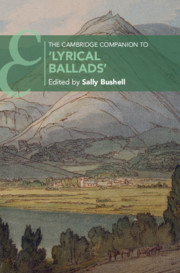Book contents
- The Cambridge Companion to ‘Lyrical Ballads’
- The Cambridge Companion to ‘Lyrical Ballads’
- Copyright page
- Dedication
- Contents
- Contributors
- Acknowledgements
- Chronology
- Abbreviations
- Introduction
- Part I Part and Whole
- Chapter 1 Wordsworth’s ‘Preface’: A Manifesto for British Romanticism
- Chapter 2 Collaboration, Domestic Co-Partnery and Lyrical Ballads
- Chapter 3 Coleridgean Contributions
- Chapter 4 Lyric Voice and Ballad Voice
- Part II Subjects and Situations from Common Life
- Part III Feeling and Thought
- Part IV Language and the Human Mind
- Part V A Global Lyrical Ballads
- Guide to Further Reading
- Index
Chapter 3 - Coleridgean Contributions
from Part I - Part and Whole
Published online by Cambridge University Press: 08 February 2020
- The Cambridge Companion to ‘Lyrical Ballads’
- The Cambridge Companion to ‘Lyrical Ballads’
- Copyright page
- Dedication
- Contents
- Contributors
- Acknowledgements
- Chronology
- Abbreviations
- Introduction
- Part I Part and Whole
- Chapter 1 Wordsworth’s ‘Preface’: A Manifesto for British Romanticism
- Chapter 2 Collaboration, Domestic Co-Partnery and Lyrical Ballads
- Chapter 3 Coleridgean Contributions
- Chapter 4 Lyric Voice and Ballad Voice
- Part II Subjects and Situations from Common Life
- Part III Feeling and Thought
- Part IV Language and the Human Mind
- Part V A Global Lyrical Ballads
- Guide to Further Reading
- Index
Summary
By 1802, Coleridge had begun to suspect what the next thirty years would confirm – that there was a ‘radical Difference’ between Wordsworth’s conception of poetry and his own (CL STC II. 830). Lyrical Ballads was the outcome of a period of initial excitement when, at the start of a relationship, each man was able to suspend his difference and, for a while, be a version of himself that met the other’s hopes and ideals. As such, it was a typical project for Coleridge, who had an intense need to be part of a literary circle in which friendship gave rise to, and was in turn intensified by, communal writing, reading and publishing. He had been co-writing or co-publishing poems with Southey since 1794; in 1797 his first verse collection included poems by his friends Charles Lloyd and Charles Lamb. Wordsworth, on the other hand, had never published collaboratively before and never would again. In a sense, then, Lyrical Ballads (1798) was a Coleridgean volume, one of many co-authored outlets for a practice of versifying that he shared with friends – a practice that was often self-reflexive: the poems were often about the shared experiences of the friends with whom they were written and/or to whom they were recited. A case in point was ‘This Lime Tree Bower My Prison’, the poem in which Coleridge first invoked William and Dorothy in the conversational voice that he and Wordsworth would develop during the next five years. The poem features Charles Lamb as well as the Wordsworths and was recited to them on the spot where it was composed. It was not, however, published in Lyrical Ballads but in Southey’s Annual Anthology alongside contributions by other members of the circle – including Joseph Cottle, the Bristol bookseller who published both it and Lyrical Ballads. This pattern suggests that Lyrical Ballads was just one of many joint publications by which Coleridge sought to promote the innovatory poetic style of the West Country circle, and in so doing endorse their group language. Other poems went into the columns of The Morning Post, where verse by Southey and by Mary Robinson (a satellite member of the group) also appeared.
- Type
- Chapter
- Information
- The Cambridge Companion to 'Lyrical Ballads' , pp. 49 - 65Publisher: Cambridge University PressPrint publication year: 2020
- 1
- Cited by

